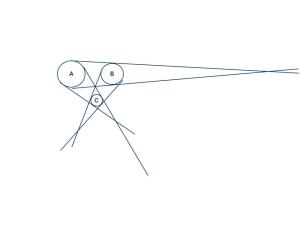I have been out of puzzle world for sometime. Leaving IIT Kanpur meant leaving company of theoretical souls such as Ramprasad, Deepanjan and Sagarmoy. Interactions with them drove me to write most of the articles I write here.
Anyways, I had an interesting chat with Ramprasad and pretty much copying the conversation.
Imagine four unit circles centred around the 4 points (1,1) (1,-1)
(-1,1) (-1,-1). All the four circles of course can be enclosed within
a square of side two (corners at (plusminus 2, plusminus 2)). Now
there is this tiny gap around the origin right? Put the largest
possible circle there that touches all these other circles. What is
the radius of this circle? I won’t insult your intelligence; by
simple geometry it is sqrt(2) – 1.
Now repeat this in 3 dimensions. Unit spheres at all points (plusminus
1, plusminus 1, plusminus 1), and draw the largest sphere centred at
the origin to touch all these sphere. What is its radius now? Again,
easy to see it is sqrt(3) -1.
Now what is the answer to the same question in n-dimensions? It is sqrt(n) – 1.
Okay good. Here is the freaky part. The (higher-dimensional)cube that
encloses all these circles is still of side-length two. The sphere you
drew at the origin has radius sqrt(n) – 1, which is way way larger
than 2 for large n. So the sphere you drew there actually *leaks out*
of the box.
I went insane after first hearing about this. It took me quite a while to get my head around this mathematical fact. Yes, indeed this is a fact, no matter how counter-intuitive it sounds. There is not catch or fallacy here. It’s hard to imagine dimensions beyond 3. But probably here is an explanation why the inner sphere *leaks* out of the box.
If it helps, imagine the following picture. Take a box of side-length
4, and put 4 circles in each of the corners that touches two sides of
the square, but make the radius of the circles something like 1/100.
Now, if you draw a circle centred at the origin but touching these
four 1/100 radius circles, you would see that the circle actually goes
out of the square in the middle of the edge. This I guess is similar
to what happens in higher dimensions. The volume of circles in higher
dimensions is really tiny.
Of course, even in higher dimensions the spheres touch the adjacent sphere which is not the case in the explanation above with circles of radius 1/100. But one can see that the cube side-length remains 4, the main diagonal of the cube is sqrt(16n). Hence, the inner sphere, does not go out of the main diagonal but it very well can *leak* out of the box from one of its face (or surface or facet, whatever you want to call them).
For N=9, it would be the first time when the inner sphere can not be fully contained within the N-dimensional box that we defined earlier.
Let’s talk about volumes The volume of a sphere of radius r in n dimension is. pi^{n/2} r^n /
Gamma(n/2 + 1) [Gamma(x) is roughly like the factorial of x, but
defined even all reals. Gamma(x) = xGamma(x-1), and Gamma(1/2) =
sqrt(pi)]. Please see more about Gamma Functions here.
Now, the thing is that the volume of an N-dimensional sphere starts decreasing after the dimension grows above 5 because the denominator increases faster as compared to the numerator in the equation of the volume!! And as N-tends to infinity, the volume approaches zero!!!
My mind has shaken up enough for the day!! That’s why I am going on a 5-day leave starting tomorrow (thanks to easter holidays).
I knew there must be a good reason why I hate geometry 🙂

